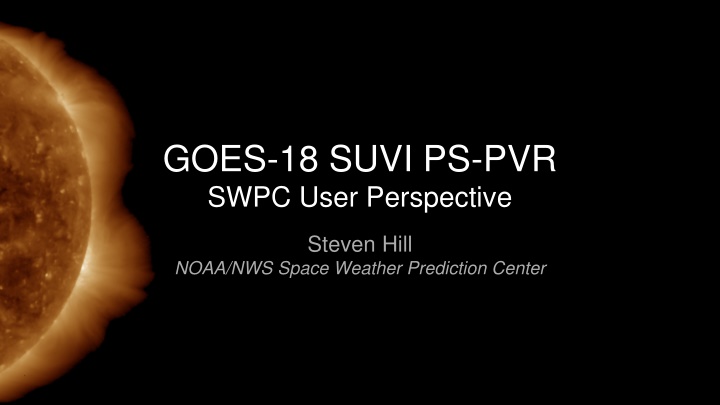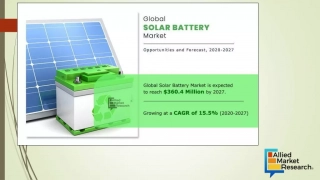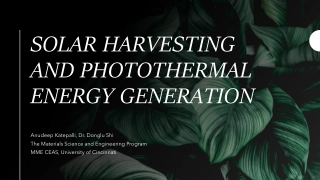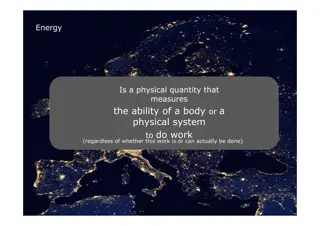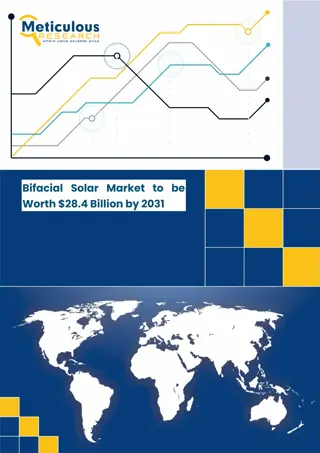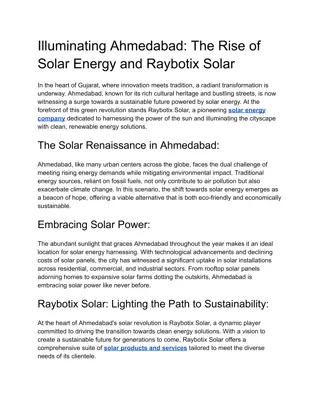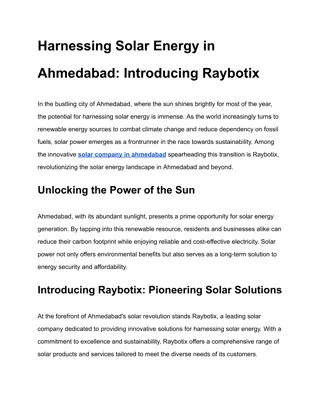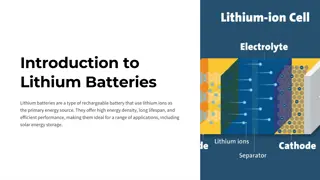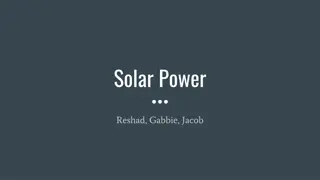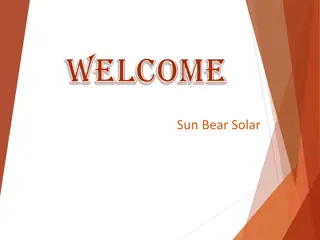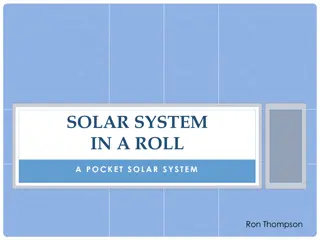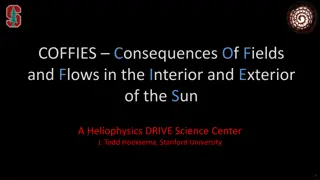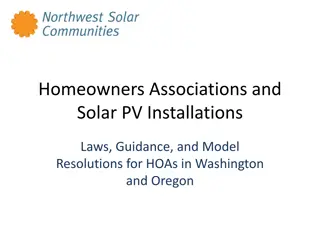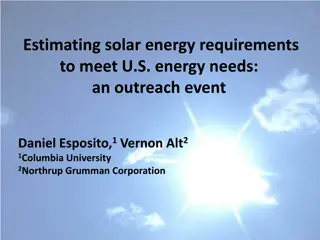Solar Activity Forecast Applications
These images showcase the data products and applications used for forecasting solar activity, providing warnings of geomagnetic storms, solar radiation storms, and more. The images also highlight the usage of various satellites and tools in monitoring and predicting solar events.
Download Presentation

Please find below an Image/Link to download the presentation.
The content on the website is provided AS IS for your information and personal use only. It may not be sold, licensed, or shared on other websites without obtaining consent from the author.If you encounter any issues during the download, it is possible that the publisher has removed the file from their server.
You are allowed to download the files provided on this website for personal or commercial use, subject to the condition that they are used lawfully. All files are the property of their respective owners.
The content on the website is provided AS IS for your information and personal use only. It may not be sold, licensed, or shared on other websites without obtaining consent from the author.
E N D
Presentation Transcript
GOES-18 SUVI PS-PVR SWPC User Perspective Steven Hill NOAA/NWS Space Weather Prediction Center
Heritage Hinode 2006- Skylab 1973-74 Yokoh 1991-2001 GOES 12 2001-2007 GOES 13-15 2006-2020 SUVI SOHO EIT 1996- SDO AIA 2010-
Forecast Applications Provide advance warning of solar activity Over the horizon look at active regions rotating onto the Earth-facing side of the sun Provide warning of recurring geomagnetic storms Tracking coronal holes as they rotate across the solar disk Provide warning of non-recurring geomagnetic storms Identify, locate, and characterize eruptions (flares, coronal mass ejections) Provide warning of solar radiation storms Identify, locate, and characterize eruptions (flares, coronal mass ejections) Assess solar flaring probability Intensity and complexity of solar active regions
Data Used primarily for situational awareness Auto updating loops with selectable Duration: 3 hrs to 8 days Speed: 10 to 60 fps Cadence: 4 min to daily
Data Products Wavelength (nm) Features and Temperature (K) Flares ~6x106 K Product Uses Flare location 9.4 Flare location Flares ~6x106 K and hot flares ~15x106K 13.1 Active region characterization Active regions ~6x105 K 17.1 Composite Images Active region characterization and flare location Active regions ~1x106 K and hot flares ~20x106K 19.5 Coronal hole location and characterization Filament location and characterization Supervised pixel classifier Coronal Holes (~2x106 K) 28.4 Filaments (~6x104 K) 30.4 Thematic Map All All
GOES 16-17-18 SUVI Status GOES 16 and 17 SUVIs are the primary and secondary EUV imagers for operations, respectively SWPC will be prepared for switch of secondary SUVI from GOES-17 to GOES-18 on January 4, 2023 SWPC is preparing for SPADES release 2.1.1 deployment on 12/8 with metadata changes ( time keyword)
Areas of Concern 30.4nm -> 28.4nm cross-talk Disentanglement of the 30.4 and 28.4 nm channels continues to be of interest to SWPC ADR 1147 SUVI GPA cannot handle additional flatfields Remains a concern because of the future potential for off-band light leaks due to pinhole or other filter failures.
Roll Navigation GOES 13-15 Residual roll navigation error was anticipated in SUVI (and seen in prior SXIs) due to nadir pointing spacecraft attitude coupling with orbit inclination errors. For G13-15, the inclination box was 0.5 deg, leading to a roll error of up to 0.5 deg Unfortunately orbit ephemeris data was not available to ground processing, so it was requested on GOES-R G16-18 Residual roll error exceeds the inclination error Thus it can only be partially resolved by rigid body coupling of spacecraft roll and orbit inclination
SUVI & SXI Research Impact (selected) Seaton, D. B., & Darnel, J. M. (2018). Observations of an Eruptive Solar Flare in the Extended EUV Solar Corona. The Astrophysical Journal, 852, L9. doi:10.3847/2041-8213/aaa28e 57 Veronig, A. M., Podladchikova, T., Dissauer, K., Temmer, M., Seaton, D. B., Long, D., . . . Kliem, B. (2018). Genesis and Impulsive Evolution of the 2017 September 10 Coronal Mass Ejection. The Astrophysical Journal, 868, 107. doi:10.3847/1538-4357/aaeac5 68 Hill, S. M., Pizzo, V. J., Balch, C. C., Biesecker, D. A., Bornmann, P., Hildner, E., . . . Zimmermann, F. (2005). The NOAA Goes-12 Solar X-Ray Imager (SXI) 1. Instrument, Operations, and Data. Solar Physics, 226, 255-281. doi:10.1007/s11207-005-7416-x 84 Liu, C., Lee, J., Yurchyshyn, V., Deng, N., Cho, K.-s., Karlick , M., & Wang, H. (2007). The Eruption from a Sigmoidal Solar Active Region on 2005 May 13. The Astrophysical Journal, 669, 1372-1381. doi:10.1086/521644 68 Temmer, M., Vr nak, B., & Veronig, A. M. (2007). Periodic Appearance of Coronal Holes and the Related Variation of Solar Wind Parameters. Solar Physics, 241, 371-383. doi:10.1007/s11207-007-0336-1 91 Veronig, A. M., Karlick , M., Vr nak, B., Temmer, M., Magdaleni , J., Dennis, B. R., . . . P tzi, W. (2006). X- ray sources and magnetic reconnection in the X3.9 flare of 2003 November 3. Astronomy and Astrophysics, 446, 675-690. doi:10.1051/0004-6361:20053112 121 Warmuth, A., Mann, G., & Aurass, H. (2005). First Soft X-Ray Observations of Global Coronal Waves with the GOES Solar X-Ray Imager. The Astrophysical Journal, 626, L121-L124. doi:10.1086/4317 65 Rotter, T., Veronig, A. M., Temmer, M., & Vr nak, B. (2012). Relation Between Coronal Hole Areas on the Sun and the Solar Wind Parameters at 1 AU. Solar Physics, 281, 793-813. doi:10.1007/s11207-012-0101-y 66
Summary GOES-R SUVIs have been an overall success so far (16-18) Updating SWPC software for SPADES 2.1.1 release SWPC will be prepared for January 4th switch to GOES-18 Areas of concern Need to be prepared for light leaks in the future Desired to address 28.4-30.4 mixing Address roll navigation error, could be a software fix on the ground with simple ephemeris & attitude data (rigid body) Thank you to NCEI & the GOES Program! For their persistence in overcoming issues and improving products For pursuing improvement by engaging with the research community
